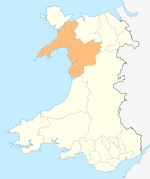Nantlle Valley — at sunset The Nantlle Valley (Welsh: Dyffryn Nantlle) is an area in Gwynedd, north Wales, characterised by its large number of small settlements. Around 80% of the population of the Nantlle Valley speak Welsh as their first language. Some of the… … Wikipedia
Nantlle Railway — Horse drawn slate wagon used on the Tramway, now preserved at the Welsh Slate Museum, Llanberis Locale Wales Dates of operation 1828–1865 … Wikipedia
Nantlle Vale F.C. — Nantlle Vale Full name Nantlle Vale Football Club Ground Maes Dulyn, Penygroes Chairman Emyr Wyn Jones … Wikipedia
Nantlle Valley — Dyffryn Nantlle Nantlle Valley Basisdaten Staat Vereinigtes Königreich ISO 3166 2 GB GWN … Deutsch Wikipedia
Nantlle Ridge — Y Garn, the usual starting point for the Nantlle Ridge walk, seen from Rhyd Ddu The Nantlle Ridge is the name given to a small range of mountains in Snowdonia, north Wales which runs south west from the village of Rhyd Ddu for a distance of about … Wikipedia
Nantlle tramway — The Nantlle tramway was a RailGauge|3ft6in gauge horse drawn tramway in North Wales. It survived, albeit truncated at Talysarn until the 1960s. The section of the line near Caernarfon was rebuilt as part of the standard gauge Caernarvonshire… … Wikipedia
Narrow gauge slate railways in Wales — The slate industry of North Wales was the largest user of narrow gauge railways in the whole of the United Kingdom. Many of the quarries had internal tramways and feeder lines connecting them to transhipment points on local railways, rivers,… … Wikipedia
Slate industry in Wales — The slate industry in Wales began during the Roman period when slate was used to roof the fort at Segontium, now Caernarfon. The slate industry grew slowly until the early 18th century, then expanded rapidly until the late 19th century, at which… … Wikipedia
Schieferindustrie in Wales — Die Schieferindustrie in Wales geht auf die Zeit der Besetzung Britanniens durch das Römische Reich zurück. Dachschindeln aus Schiefer wurden bereits beim Bau eines römischen Lagers in der Nähe des heutigen Caernarfon verwendet. Bis zum Beginn… … Deutsch Wikipedia
Welsh Highland Railway restoration — The restoration of Welsh Highland Railway has a colourful and complex history. This article provides the modern history: Welsh Highland Railway LimitedAfter the 1944 winding up of the old 1922 company, a few articles appeared in the railway press … Wikipedia


